Introduction
The research methodology is a way to resolve systematically the associated research dilemmas; however, this chapter presents the study’s selected research approach, which is designed considering the objectives of this study, Malhotra’s six steps of research approach, and so on. To analyze the topic “different strategies used in Coca Cola and Pepsi’, this chapter will review the purpose of the study to formulate the research questions and hypothesis, discuss the data collection along with analysis methods and the limitations of the study, the deductive versus the inductive approach and the qualitative versus the quantitative approach.
Purpose of Study
The overall purpose of this study is to analyze different strategies used in Coca Cola and Pepsi by considering different national and international issues related to consumer preferences and post-recessionary impact on the firms in the global market. This research paper will find out the most influential facts for these two companies, such as, several competitors enter the market with new products in the soft drinks industry, the unstable political situation in many countries for which sales revenue from the international market of these two companies is decreasing gradually.
On the other hand, the purpose of this study is to find out similarities of the strategies of these two companies for the local and international market to meet the challenges, for instance, the initiative of the management teams to comply with the guidelines of Food and Drug Administration, resource management to handle new projects and so on. At the same time, this paper will assess the performance of these companies in adverse economic, social, and political conditions to make decisions regarding future investment in the local and international market for further business expansion both vertically as well as horizontally. Furthermore, this study aims to assess the extent to which these companies meet market demand and customers’ expectations; besides, it measures the effectiveness of social media strategy, sponsorship, and other promotional strategies to hold market leadership in the soft drinks industry.
Research Question
To what extent is a business-level strategy, pricing strategy, brand promotion strategy, new product development, and market expansion strategy are effectual to manage the company in the global market.
Research Problem
Yoffie & Wang (2004, p.1) investigated the carbonated soft drinks industry, it’s market players specially Coca-Cola and PepsiCo, their competitive strategies at home and abroad along with their rivalry that is going for over a century and continues with a new dimension of strategies to defeat each other. With rising sales revenues, both the companies have aligned with modified branding strategies along with newer bottling and pricing policy, they engaged highest effort to gain market share in the emerging markets to strengthen brand portfolios by expanding their operation in the non-carbonated soft drinks such as fruit juice, tea, sports drinks, along with purified water bottling. The beverage industry giant Coca-Cola and PepsiCo has been enjoying lion market all over the globe with intensive battles and continuous market growth, in the USA it is around $60 billion industry, the US families consume these soft drinks 53 gallons per head, and the consumption has been increasing at the rate of 10% per year.
In the battlefield of China as per data presented in 2010, the demand for the carbonated beverage is only growing 30 million liters per year while the US market is losing 300 million per annum and China placed at third position for carbonated beverage consumption with an annual requirement of 4500 million liters per annum accounted (Liu & Smit, 2012, p.1). Coca-Cola enjoyed competitive advantages in China due to its earlier entry, prior distribution channels and gained the position of the market leader in the soft drinks market while PepsiCo penetrated the market three years later in 1982 and put into practice of differentiation strategy targeting the new generation and thrown a challenge to the monopoly of Coca-Cola at its Chinese operation. On the other hand, in the Chinese market, there are 400 million Internet connections along with one billion mobile phone users, which provided the marketers greater opportunity to connect people through social media or one short messaging system with very lower cost; thus, PepsiCo challenged the market-leading position of Coca-Cola through the right use of every resource.
Instrument
This research conducted a survey of the customers and employees (distribution channels, restaurants, fast food stores, and so on) of the carbonated soft drinks industry and the selected companies are Pepsi and Coca Cola since these two companies are top two market leaders in the industry. However, the survey instrument was distributed amongst the participants using different systems; in this case, the research had requested the employees and the customers to provide their valuable time to complete the survey form or questionnaire. As the questionnaire has included simple questions, it should take three to five minutes to complete, but if the participants would like to explain their view then they should require additional time to complete the survey; however, it can be assumed that very few respondents would provide extensive analysis. On the other hand, the researcher had communicated with the respondents to request them to complete the survey report, and to do so the researcher used the email address of the respondents; also, he briefly explained the purpose of the study for which the participants would be interested.
The Research Site
The research sites are Pepsi and Coca-Cola Company because these companies are the market giant in the carbonated soft drink industry; besides, these two MNCs are strong competitors of each other for over a century. At the same time, these companies are the most popular soft drinks manufacturers and these companies have a strong presence and brand awareness in the global market; also, Coca Cola is the largest beverage company in the world and it has 500 non-alcoholic beverage brands (top four brands Coca-Cola, Diet Coke, Fanta, and Sprite).
Population
The researcher would prepare a questionnaire with several simple questions (includes easy language to understand) regarding different strategies of Pepsi and Coca-Cola and this questionnaire would be distributed to the employees and customers of these two companies. At the same time, this questionnaire would be distributed among 150 employees, but it expected that not all the participants would complete the questionnaire; however, the researcher received 100 complete survey reports on time. The questionnaire included open-ended for which the customer and employees get the opportunity to explain their views broadly; however, the researchers interviewed a few respondents using a tape recorder to get qualitative feedback from the participants.
Sample
Among the target respondents, 61 male and 39 female participants have provided their valuable time and effort to meet the researcher’s objectives and to contribute to the development. From the feedback of the respondents, it identified that a larger part of the respondents was age group between 15 and 35 and they were educated people; also, a significant part of the respondents used social networking site particularly Facebook; however, the following table gives more detail in this regard –
Table 1: Profiles of Questionnaire Respondents. Source: Self-generated.
Data Collection
In this study, two types of data, such as primary and secondary data would use to discuss different strategies of Coca-Cola and Pepsi; however, there are many ways to collect such data for the present study. Primary data can be collected using an experiment or survey method considering the nature of the research (Saunders, Thornhill & Lewis 2006; Jackson 1994 and Cohen, Manion & Morrison 2007). For instance, observation without interviewing process is an effective method of data collection where the researchers deal with concurrent issues; however, it is an expensive method though it is possible to gather limited knowledge from this method (Sekaran 2006; Malhotra 2009; and Cohen et al. 2007). At the same time, the researchers had the opportunity to use personal interview where an examiner considers a rigid process and seeks answers to a set of pre-conceived questions; besides, they can consider the telephone interview method though it is not a very widely used method, it has significance in case of industrial surveys with the limited time frame. However, the researcher of the present study would collect data by mailing questionnaires to the customers and employees of Pepsi and Coca-Cola since it is the most extensively used system in different economic and business surveys; therefore, the questionnaire forms were mailed to the participants with a request to return after finishing the same (Sekaran 2006).
Discussion of Results
The personal information will be kept confidential, which has been gathered through the survey; indeed, the respondents were assured in the questionnaire that personal identifying information will not be revealed at all; however, the subject area of the research was simple where it is not too important to take confidential informant. However, collected information would be assessed to find out any errors, and then it would be presented as report format with chart and graph using popular the software Microsoft Excel; also, the research must be kept away from bias to analyze the descriptive area of the research.
Research Approach
There are two basic approaches to research (Saunders, Thornhill & Lewis 2006; and Cohen et al. 2007). These are, for instance, qualitative and quantitative research approaches (sub-classified as inferential, experimental and simulation approach), which organize with the generation of data in, quantitative form (Sekaran 2006; Malhotra 2009; and Cohen et al. 2007).
The Deductive versus the Inductive Approach
Induction is typically illustrated as moving from the precise to the general, whereas deduction starts with the general and ends with the precise for testing theories (Burney 2008, p.5; Sekaran 2006; Malhotra 2009; and Zikmund 2006); however, the following figure illustrates the difference between the deductive and the inductive approach –
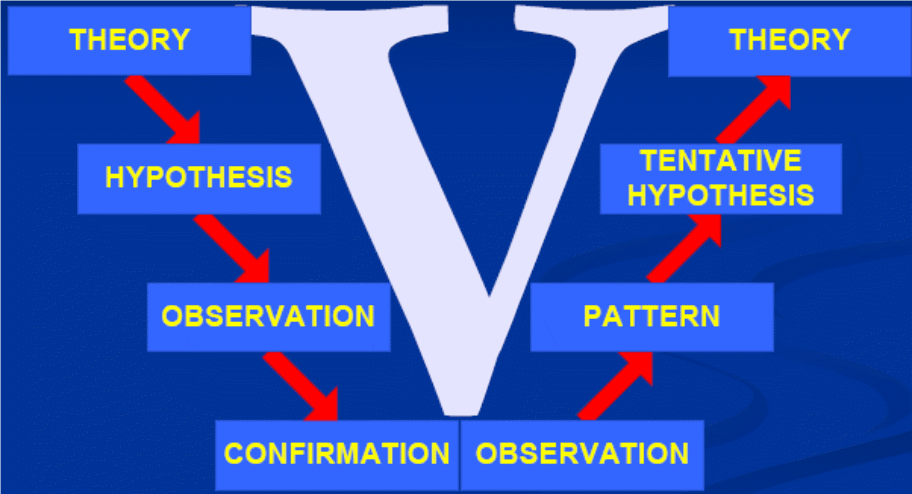
As a result, the research of the present study had considered deductive approach as it is suitable with the topic area “different strategies used in Pepsi and Coca Cola” and it is beyond the expertise of the researcher to develop a theory through observation.
The Qualitative versus the Quantitative Approach
The quantitative research approach is based on the measurement of quantity; thus, it is acceptable in such phenomena where the data can be quantity, for instance, scientific research (Cohen et al. 2007; Leung 2012 and Sekaran 2006). In contrast, the qualitative research approach is related to the qualitative phenomenon, which cannot be quantified, such as, research on human behavior (why individuals think or perform certain activities) (Saunders, et al. 2006; and Cohen et al. 2007). In this case, the researcher of the study raised some specific issues (on the strategies of Coca Cola and Pepsi) in the objective section, which is possible to measure using a quantitative research approach. On the other hand, the participants of the research get no chance to explain their answer under the quantitative research approach for which it becomes difficult for the researchers to identify proper research outcomes (Zikmund 2006; Cohen et al. 2007; Malhotra 2009; Saunders et al. 2006; and Leung 2012). In this context, the researcher of the current study includes some open-ended questions in the questionnaire for the respondents to describe their opinion regarding the key determinants of operational success and different strategies of Coca Cola and Pepsi; therefore, it can be said that the researcher has selected both qualitative and quantitative research approach.
Summary
The main objective of this chapter was to design a methodological framework to serve the purpose of the present study, for instance, the researcher had selected both qualitative and quantitative research approach to analyze different strategies of Pepsi and Coca-Cola; besides, the investigator has also decided to use both primary and secondary data sources.
Analysis of Results
Introduction
This chapter of the research has organized to summarize the overall research along with findings, social media strategy, business-level strategy, brand promotion strategy, sponsorship, pricing strategy, and other following subheads –
Social Media Strategy of Coca-Cola and PepsiCo
Liu & Smit (2012, p.1) pointed out the Cola War between Coca-Cola and PepsiCo has gained a new shape in the modern information technology era, the traditional battle of brand competition sustained over their distribution channels, advertising media, retail outlets, and sports event organizing, but now it has gained a new media to continue their fighting through social media. The battlefield of Coca-Cola and PepsiCo war has evidenced in the USA and China that pointed to the insights of the companies how ugly their fighting is they have engaged to identify a new way of competition in the social media platform by engaging huge investment to assemble a reliable and logical brand image by damaging one another online.
Although the adoption of social media strategy of both companies is very different, the aim and objectives are the same, both of the companies intend to gain long-term and short-term returns from the investment in this new media with the changing dimension of the beverage market globally. The reason behind their irrevocable competition and investing in social media marketing is that the fortunate time to expand the carbonated beverage market has possibly ended; in the highly consumed countries like the USA, it has evidenced negative growth from the starting of this millennium. Moreover, the lower consumed countries have little growth but not at a satisfactory level, for instance, it was predicted that from 2005 to 2010 the growth would be 7%, but it gained less than 1% with a per capita consumption of one-twentieth of the US market (Liu & Smit 2012, p.1)
In 2010, PepsiCo reduced 50% of its traditional branding budget and moved that investment to social media to promote the ‘Pepsi Refresh Project’ that urged people to explain their views to ‘refresh’ the society where the company would make financial contributions to encourage the highest voted idea. At the same, time Coca-Cola explored 206 social media campaigns on different platforms to promote ‘optimistic and happy’ for a year where the highest voted concept would get tickets for Olympic Games 2010 and facilitate them to participate in the new cast from the game fielding Shanghai. In that social media campaign, PepsiCo has gained more extended brand disclosure through its ‘refresh the world’ and was capable to create a center of attention for particular consume group while the social media campaign of Coca-Cola has gained very poor attention of the customers where the very unsatisfactory figure of fans and followers integrated their options in the campaign.
Do you think that the social media strategy of Coca-Cola is more effective than PepsiCo?
Among the target respondents, 54% of the total participants agreed and strongly agreed with the question, 43% of interviewees disagreed or strongly disagreed, and only 3% of respondents were neutral with the question; however, the next figure represents data graphically-
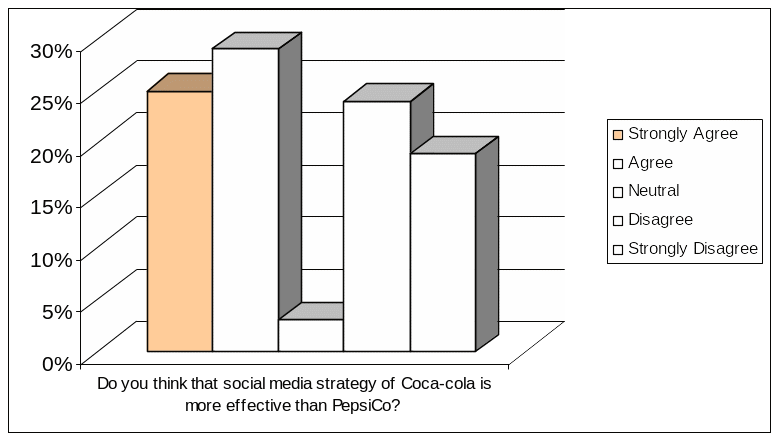
Do you think that the Social Media Strategy of Pepsi should change to compete with Coca Cola?
From the response of the customers and employees, 65% of the total participants agreed and strongly agreed with the question, whereas 32% of interviewees disagreed or strongly disagreed, and only 3% of respondents were neutral with the question; however, the next figure represents data graphically-
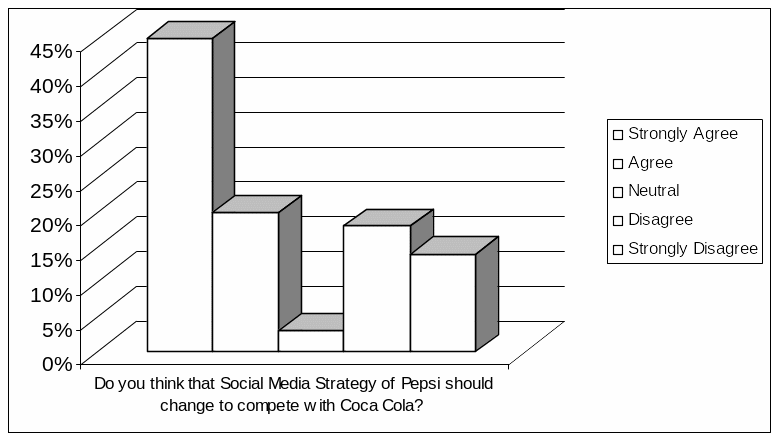
Brand promotion strategy of Coca-Cola and PepsiCo
Bhushan (2013) pointed of that PepsiCo was aggressive to be the title sponsor of the IPL (Indian Premium League) 2013 and purchased the sponsorship for the next five years for Rs 4 billion at the rate of Rs 800 million per year, the company further spent RS 600 million to be one of the two presenting sponsors with a TV channel. The channel SET Max has allows maximum airtime channel for PepsiCo at the time of IPL broadcast, the company also became a drinking partner of the tournament for RS 100 million to promote its brand image in the Indian market while the brand experts in India have identified it as a bulk investment for brand promotion.
To encounter such a bulky branding strategy, Coca-Cola presented a reduced pricing strategy during the IPL tournament and conducted the advertising campaign “Refreshment at Rs 8” with the belief that customers would positively drive to the low price offer without looking to the sponsorship deals of the rival PepsiCo. Coca-Cola explained that the company has taken into account the market reality of the summer season while the market demand goes higher and its communication strategy has aimed to demonstrate that the company is giving a tremendous cost-saving opportunity for consumers that would supersede the heavily invested barding strategy of PepsiCo. In the Indian market, the brand promotion strategies of the two companies have evidenced that PepsiCo has aligned with a high investment intensive branding strategy while Coca-Cola followed the lower pricing strategy to encounter its rival in the Indian market.
Do you think that the brand promotion strategy of Coca Cola is more effective than PepsiCo?
Among the target respondents, 47% of participants strongly agreed with the question, 24% of interviewees agreed, and only 3% of respondents were neutral while 14% of participants disagreed and 12% of respondents strongly disagreed that the brand promotion strategy of Coca-Cola is more effective than PepsiCo; however, the next figure represents data graphically –
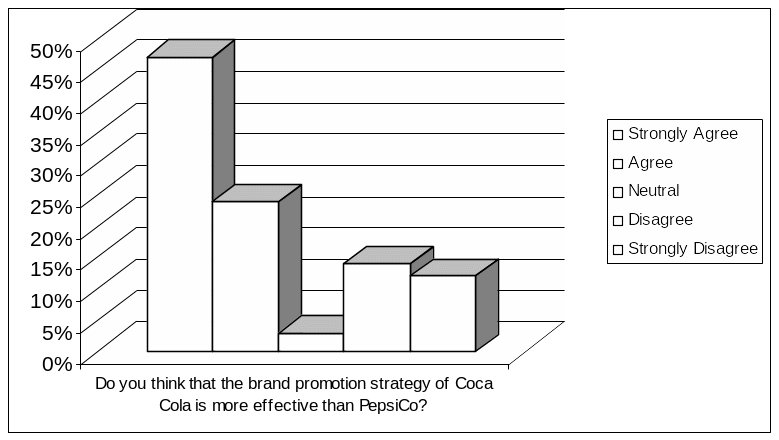
Pricing strategy
The CEO, management team, and board of directors of Coca-Cola have decided that they will set price considering the competitor’s price, but it must be affordable to the customers (Lin 2012; and Fourni 2012). According to the annual report 2012 of Coca-Cola, it is truly a global company, which is successfully carrying on a business for more than a century; however, pricing strategy plays a vital role to experience tremendous accomplishment. At the time of the global recession, the marketers had analyzed the global market condition to many pricing decisions with the intent to maximize shareholder value and to grab market share; however, it is important to notice that the decision-makers of this company decreased the price of some products (like reducing the price of 200ml container), but not all products (Fourni 2012). At the same time, this company uses lower price to enter new markets, which are particularly sensitive to price to meet the competitive forces and to increase brand awareness among the target customers; moreover, it focuses on the brand-positioning map, a moment of joy & happiness, and other cultural factors (Fourni 2012).
The carbonated Soft Drinks industry in the global market is mature enough due to large population growth and the number of promotional activities; however, these companies have resorted to pricing discrimination strategies to exploit the value of customer demand (Angelkov, Black & Green 2003; Rappeport 2011 and Golan, Karp & Perloff 1999). Furthermore, direct price discrimination is one of the most common pricing strategies to Pepsi and Coca Cola; however, the companies like to apply this strategy to set the price of the products because the price structure under this system based on the location and purchasing power of the customers (Angelkov et al. 2003, p.5). The price of Carbonated Soft Drinks of different companies in Mexico, Bangladesh, India, China- and other Asian countries are lower than prices in the US even though the manufacturing cost is almost the same; however, it also depends on distribution channel and supply chain management (Angelkov et al. 2003, p.5; and Golan et al.1999). Furthermore, the management and marketers of these two companies have concentrated on several factors related to costs in the supply chain, unit-based pricing system, and so on (Angelkov et al. 2003; Rappeport 2011 and Golan et al. 1999).
Do you think that the pricing strategy of PepsiCo helps to increase customer value?
The purpose of this question was to know the opinion of the customers and employees of these two companies regarding the pricing strategy of Pepsi to suggest the company regarding the pricing structure for the future development in the global market. However, it is interesting that the position of these two companies in the global market is not the same, but the response regarding pricing strategy is similar and most of the respondents provided positive feedback about this strategy while the price is affordable to the customers all over the world. However, the following figure gives more detail about respondents view regarding the pricing strategy of Pepsi –
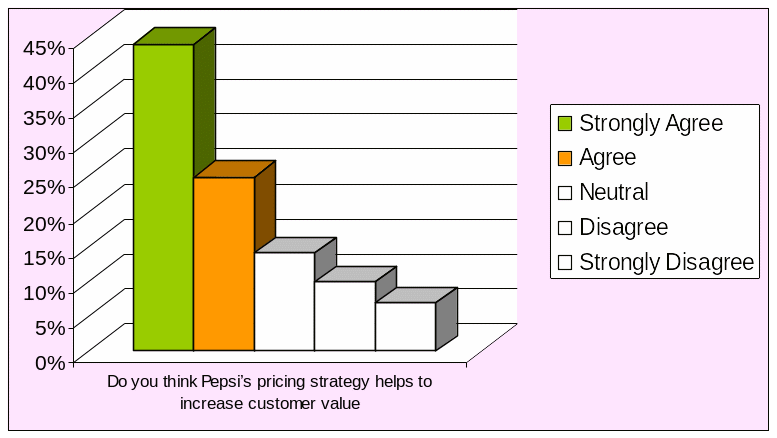
According to the survey report, highest 44% of the participants strongly agreed, 25% of respondents simply agreed with the question, 14% of respondents were neutral; however, 17 respondents have disagreed or strongly disagreed with the statement that the pricing strategy of Pepsi that it helps to increase customer value.
Do you think that the pricing strategy of Coca-Cola would assist to increase customer value?
The responses of the respondents demonstrate that the customers are satisfied with the pricing strategy of this company while they can purchase it at a reasonable price; however, the next figure shows more information about respondents view regarding the pricing strategy of Coca Cola-
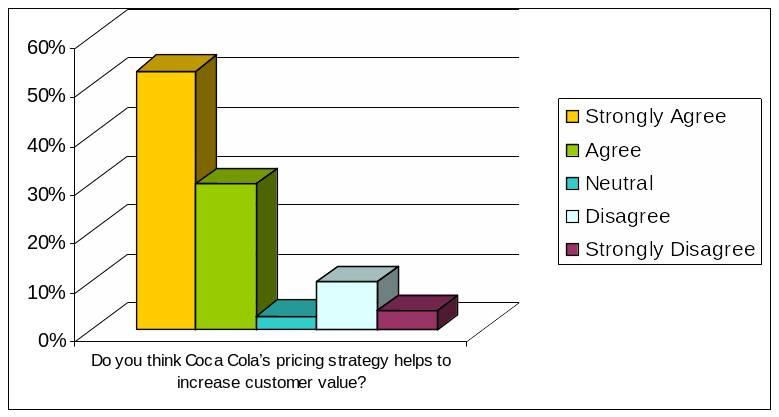
From the response of the target group, 53% of the total respondents strongly agreed and 30% of interviewees agreed with the question, 3% of respondents were neutral; on the other hand, 10% of participants disagreed and only 4% of interviewees strongly disagreed with the statement that the PepsiCo’s pricing strategy helps to increase customer value.
Do you think Pepsi and Coca Cola should restructure their pricing strategy?
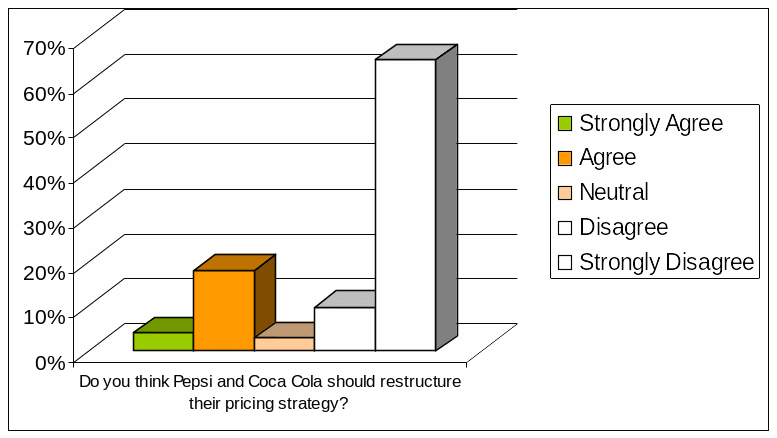
Among the 100 respondents (customers and employees), only 4% of the total participants strongly agreed and 18% of respondents agreed with the statement, 3% of respondents had no opinion in this regard; interestingly, 65% of the total participants strongly disagreed and 10% respondents disagreed with the question that Pepsi and Coca Cola should restructure their pricing strategy. Therefore, from the response, it can be concluded that pricing strategy has no impact on the customer as both companies ask for a similar price; besides, the common recommendation for these two companies that there is no need to change the existing pricing strategy for the future development.
Market Expansion Strategy
Stafford (2013, p.1) pointed out that the market expansion strategy of Coca-Cola has aimed to add new 2 billion customers by 2020 all over the world and it has targeted the middle-class people in the rural area as well as farming neighborhoods to the big cities where the products are not yet expanded. To implementing such high ambitious market expansion strategy, the company proclaimed that it will invest further US$ 30 billion in the global market within the next five years, the motivation of such a big target has empowered by its vision 2020 that aimed to make its revenue twice over than 2010 which was 100 billion. The market expansion strategy has aimed to emphasize the market of India and China where Coca-Cola products are not yet reached due to hazardous communication, transportation, and electricity supplies, but the area has more population density in the remote rural areas. The company thinks that within a decade, by eradicating poverty and corruption the rural areas of those markets would gain an infrastructural development especially road communication and electricity which is the top priority of those governments and the people of those areas would be interested to spend money for carbonated beverages.
On the other hand, PepsiCo (2012) announced its market expansion strategy arguing that it would boost advertising and marketing efforts in the global market by investing an additional US$ 500 to US$ 600 million during 2012 with special attention to the US market where it is accelerating smoothly, the company expects that it would result in higher revenues growth. At the same time, PepsiCo aimed to implement a Multi-year productivity scheme intended to engender US$1.5 billion of cost savings within the year 2014 by reengineering the operational practices and implementing structural changes that would reduce around 8,700 of its working force, which is 3% of its present global employees. Stafford (2013, p.1) added that PepsiCo also emphasized the market expansion in China arguing it as the numbered one market next to the USA and planned to invest in bottling project with a joint venture with local beverages company, the company would also expand food manufacturing plant in China and India.
Do you think that Pepsi’s market expansion strategy is advantageous for the company?
Among 100 respondents, 33% of interviewees strongly agreed that the market expansion strategy of Pepsi is advantageous, 39% of participants agreed to the question, and 8% of respondents were neutral or have no idea in this regard for which they selected option three. On the other hand, 16% of the total participants disagreed with the statement, and only 4% of respondents strongly disagreed with the question that Pepsi’s market expansion strategy is advantageous for the company; however, the survey report demonstrates that the market expansion policy is quite inspiring.
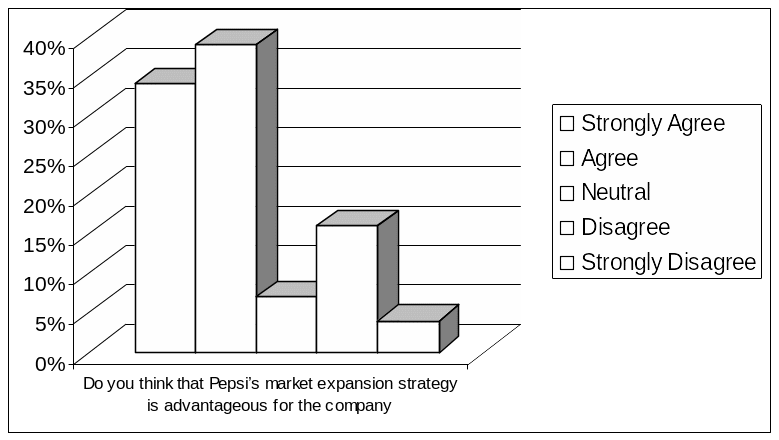
According to the annual report 2012 of Pepsi, this company considers both horizontal and vertical expansion strategy to gain a competitive advantage in the global market place, but it failed to manage the company in different regions because of taxation policies of the governments, adverse economic condition, and so on. As a result, the survey reports have not demonstrated the actual position of this company since secondary data sources explain that market expansion strategy is difficult to control for this company.
Do you think that Coca Cola’s market expansion strategy is advantageous for the company?
From the survey report, 50% of the total interviewees strongly agreed that the market expansion strategy of Coca-Cola is advantageous, 33% of participants agreed to the question, and only 2% of respondents were neutral since they do not know this matter. In contrast, 12% of the total interviewees disagreed with the statement, and only 3% of respondents strongly disagreed with the statement arguing this strategy is not advantageous for the company; however, the primary data shows that the market expansion plan is too impressive –
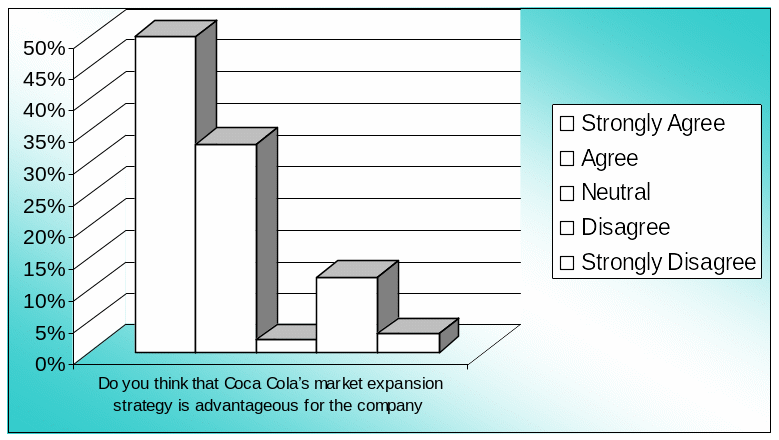
Business-Level Strategy
BenLud (2013) has engaged his effort to identify the business level strategy that Coca-Cola applies at its operation and pointed out that that the company engages to adopt differentiation strategy to uphold its uniqueness as well as the specialty of its products over the other market players. By adopting a differentiation strategy, Coca-Cola prepares its carbonated beverages along with services in a unique and valued way, which the competitors could not copy, the company provides huge non-priced attributes those customers get as a premium sanctioned by this global beverage giant. At the same time, the company differentiates operation through its dignified and unique marketing approach, exceptional advertising campaign, diverse bottle shapes, increasing customer satisfaction, and strong brand loyalty that there is none competitor to encounter with the higher degree of differentiation that Coca-Cola put into practice. Another remarkable differentiation strategy of Coca-Cola is its ‘Freestyle machine’ that facilitates the customers to mix up the traditional beverages with numerous special flavors, the company also continues its research and development project to engage with further differentiation to continue its dignity superior to other competitors in the market
Karanis (2013, p.1) explored that the corporate level strategy of PepsiCo has been providing its customers a diverse range of products and services with strong brand gratitude that generating from the company’s business-level strategy strongly aligned with differentiation, while its rival Coca-Cola practice the business-level strategy at its global operation. The company always keeps its efforts to bring newer product range in the market to deliver a competitive advantage for PepsiCo, in every business units of the company in the food and beverage sector including its Asian, American, European, and African operation it has engaged the same degree of business-level strategy. The business-level strategy of differentiation at relevant geographical regions of PepsiCo guides the functional level strategies to emphasize innovation to generate new recipes from different elements like enzyme pepsin that assist people to meet the requirement of digest and to boost necessary energy level. At the same time, the business level strategy of PepsiCo has amalgamated with the lower cost differentiation that generates economic scale of advantage in the course of its mass production of different products with a dissimilar variety of test and flavor from the competitors.
The positioning of Product Line Extension of Coca-Cola and PepsiCo
Mittal (2010, p.27) pointed out that both the companies PepsiCo and Coca-Cola have a variety of products into their basket those are targeted to unusual market segments where they feel difficulties with regular items and the positioning are completed in that way where the brand gain attributes to address any segment of the society of localization smell for consumers. For instance, Coca-Cola’s Thums Up and the Mountain Dew of PepsiCo have targeted to address the exploratory as well as energetic individuals who are paying attention to adventurous events and devoted to encountering risk to bring success, the advertising theme of both brands have tried to position consumer’s mind that they are taking ‘strong’ soft drink. PepsiCo’s product ‘Gatorade’ has aimed to a position at the mind of sportspeople and the company introduced it as a sports drink and gained tremendous success in the market, but unfortunately, its promotion has mostly constrained in the sporting events due to propagating it as a sports drink. The ‘Minute Maid’ of Coca-Cola and PepsiCo’s’ Tropicana’ has developed to meet the demand of health-conscious customers and introduced them as health drink that contains natural energy, both the drinks introduced within the class of fruit juices to divert customers from another segment who aligned with fruit juice producers.
Do you think that the business level strategy of Coca Cola is more effective than PepsiCo?
The purpose of this question is to know the viewpoint of the customers and employees of these two companies regarding business-level strategy; here, it is important to mention that the customer has no idea about the strategy of the company but they can address product differentiation issues of the company. However, among the target respondents, 48% of participants strongly agreed, 19% of interviewees agreed, and only 5% of respondents were neutral whereas 12% of participants disagreed and 15% of respondents strongly disagreed with the question that the business level strategy of Coca Cola is more effective than PepsiCo; however, the next figure represents data –
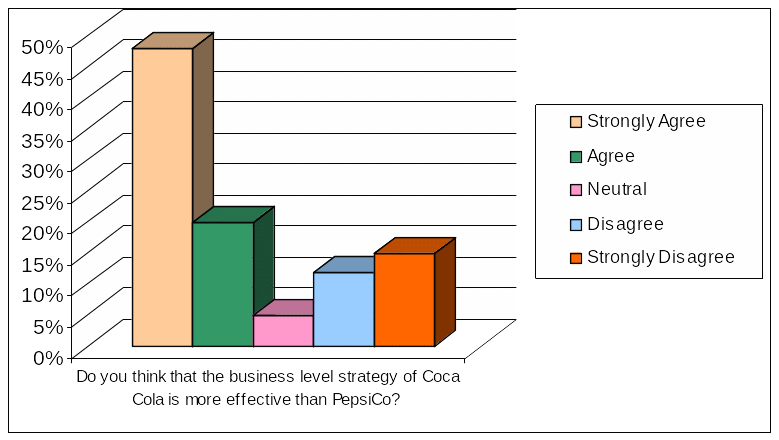
Sponsorship
Many researchers have pointed out that sponsorship is mainly a commercial activity where the sponsoring company gets right to promote groups with the sponsored object intended to get benefits; it is the underwriting of a particular event to support business goals by enhancing the commercial image, growing brand awareness, inspiring the customer and increasing sales revenue (Andersson, Arvidsson & Lindström 2006).
At the same time, there are many issues involved to generate profits, so, the multinational companies concentrate on the sponsorship activities, such as, development of brand awareness along with the brand image, and corporate image; however, the companies also using numerous advertising techniques which planned to expose the sponsoring brands to attract potential customers (Andersson et al. 2006). On the other hand, event sponsorship (sports, music, and festival-related event) has become extremely popular; however, sports sponsorship is the most common sponsorship activity for Pepsi and Coca-Cola (Andersson et al. 2006).
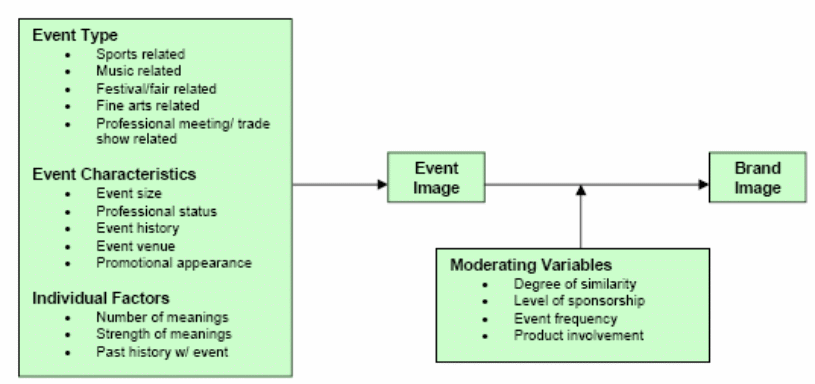
Do you think Pepsi’s Sponsorship strategy is effective in a global context?
The objective of this question was to evaluate the perception of the customers and employees of Pepsi regarding the sponsorship strategy to recommend this giant about the benefits of sponsorship for the future development in the global market place; however, the next figure provides more information about participants’ view –
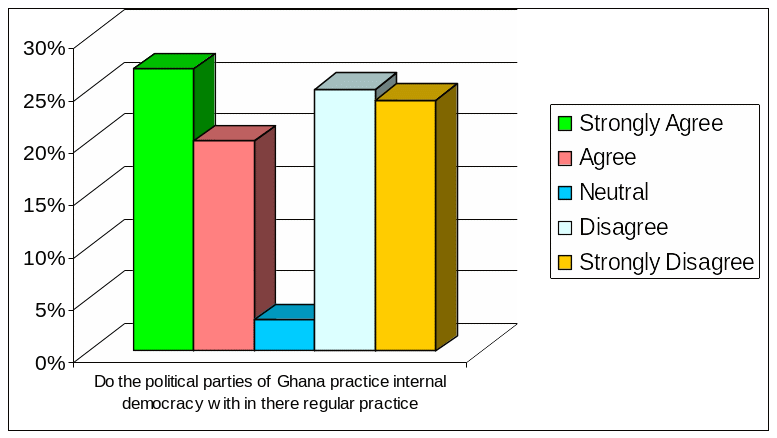
According to the primary data, 27% of the total participants strongly agreed and 20% of respondents agreed that Pepsi’s sponsorship strategy is effective in the global context; on the other hand, only 1% of respondents were neutral, but 25% of interviewees disagreed and 24% respondents strongly disagreed with the question.
Do you think Pepsi need to change their sponsorship policy?
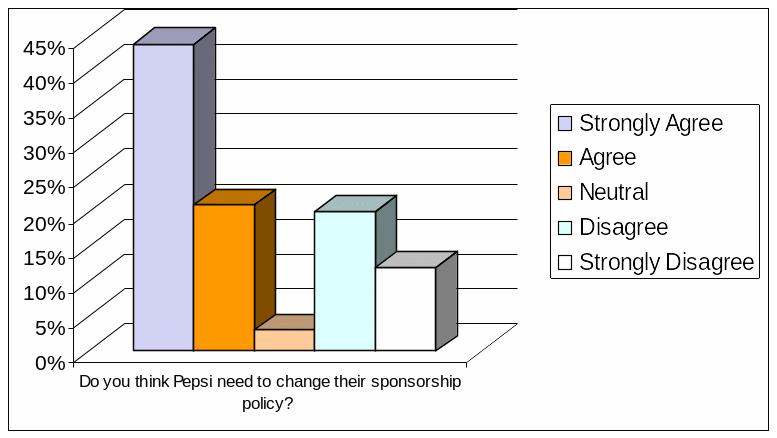
From the feedback of 100 respondents, 44% of the total respondents strongly agreed, 21% respondents agreed with the content of the question, and 3% of respondents had no opinion on this issue; at the same time, 20% of the total interviewees strongly disagreed and 10% target people disagreed with the question regarding Pepsi’s Sponsorship strategy. So, from the above discussion, it can be stated that the sponsorship strategy of this company is not enough strong in the global context though it has a long tradition in this respect and it gained a competitive advantage in someplace like India by sponsoring cricket; in this context, it should rethink about this strategy to get better outcomes.
Do you think Coca Cola’s Sponsorship strategy is effective in the global context?
This question aimed to assess the perception of the customers and employees of Coca Cola regarding the sponsorship strategy to suggest the company regarding sponsorship activities for the future development in the local and international market. On the other hand, it is important to note that both Pepsi and Coca-Cola have invested a large amount of money for sponsorship, but the response from such initiative is not the same while the respondents provided enough positive feedbacks regarding the sponsor strategy of Coca Cola. However, the next figure gives more detail about the participants’ view regarding Coca Cola’s Sponsorship strategy –
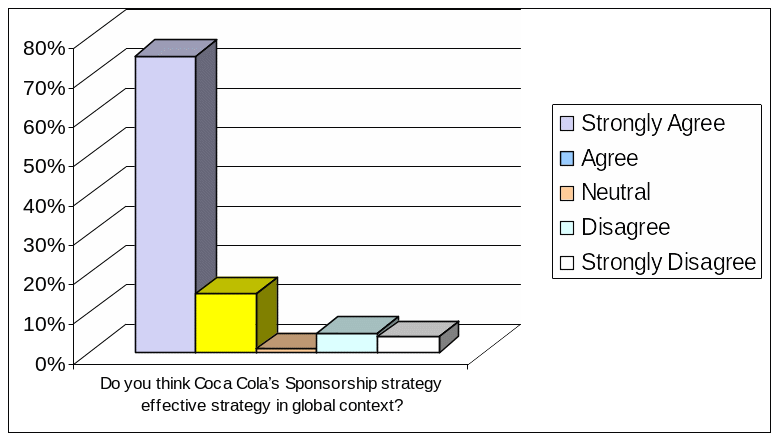
According to the primary data, 75% of the total participants strongly agreed and 15% of respondents agreed that Coca Cola’s sponsorship strategy is effective in the global context, only 1% of respondents were neutral; also, 5% of interviewees disagreed and 4% respondents strongly disagreed with the question.
Do you think Coca Cola need to change their sponsorship policy?
This question had designed with the intent to gather knowledge about the need to changing decision regarding sponsorship; for instance, in American Idol, it presents different themes and activities to encourage families and in the Olympic Games, it shares the Olympic Values.
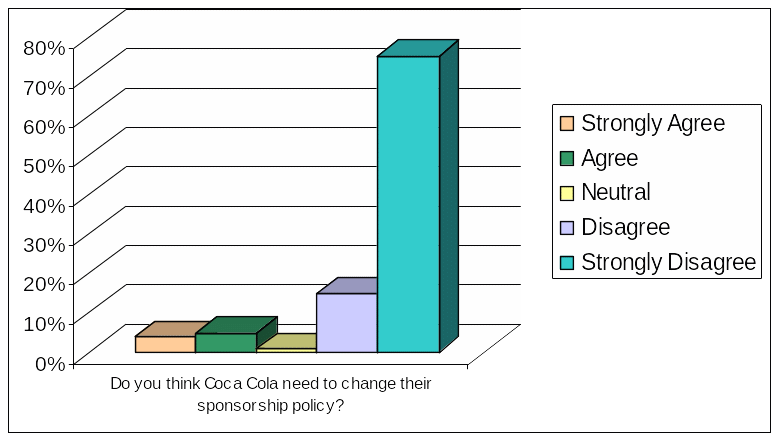
Among the 100 respondents, only 4% of the total participants strongly agreed and 5% of respondents agreed with the content of the question, 1% of respondent had no opinion in this regard; interestingly, 15% of the total participants strongly disagreed and 10% of respondents disagreed with the question regarding Coca Cola’s Sponsorship strategy. Therefore, from the above discussion, it can be concluded that the sponsorship strategy of this company is enough strong in the global market place and it gained a competitive advantage over the competitors using such strategy; besides, it has a long tradition in this respect for which it should carry on this strategy according to their way to attract more customers.
New Product Development
Coca-Cola (2012) reported that the company is always eager to change the elements of its bulk production of carbonated beverages with a complex progression through vast research and development to overcome associated challenges process, special attention has given to reduce the level of sugar and calorie contented into soft drinks for great taste and health safety. From 2007 up to now, it has reduced the calories of different products from 30% to 56%, the eighty years old brand ‘Fanta’ has evidenced with almost ninety different tastes and flavor, and in 1997 it launched “Diet Fanta Orange” as a sugar-free edition of the beverage. In 2004, with an improves taste the same brand came into the market with the name “Fanta Orange Zero” which gained higher customers preference, the process of new product development is an ongoing process for Coca-Cola and it is now working to improve Fanta like “sweet-tasting orange” for the customers of the UK market. The company also keeping its continuous efforts to substitute the sugar with an improved organic ingredient Stevia produced from the leaves of plants that contains zero calories, instead of artificial colors the company is very careful to replace them with natural color from carrot and pumpkin, the combination of such organic elements would assist to enhance its health-conscious customer base.
PepsiCo Inc. (2012) announced that the company has established a state of the earth research laboratory to develop new products extremely healthier than its competitors in the carbonated beverage, and packaged food market, at the same time the company introduced a graduation fellowship course at Yale School of Medicine to support its research and development. The company would like to be the pioneer of nutritional science research and implication other than its competitors that would generate enhanced competitive advantage for PepsiCo in long run to shift to the healthier assortment of new products in the foods and beverages industry. The new product development attributes of PepsiCo has been evidenced with a reduction of 70% fat and utilization of fresh premium orange juices along with the reduced amount of preservative for its product line that would enhance the health conscious people to choose its brand.
Do you think that Pepsi’s new product development strategy considers customers’ health and high quality?
From the response of the survey reports, about 49% of the total participants strongly agreed and 20% of interviewees agreed with this question, and only 3% of respondents were neutral; however, 10% of participants disagreed and 14% of respondents strongly disagreed with the question that Pepsi’s new product development strategy considers customers’ health and high quality.
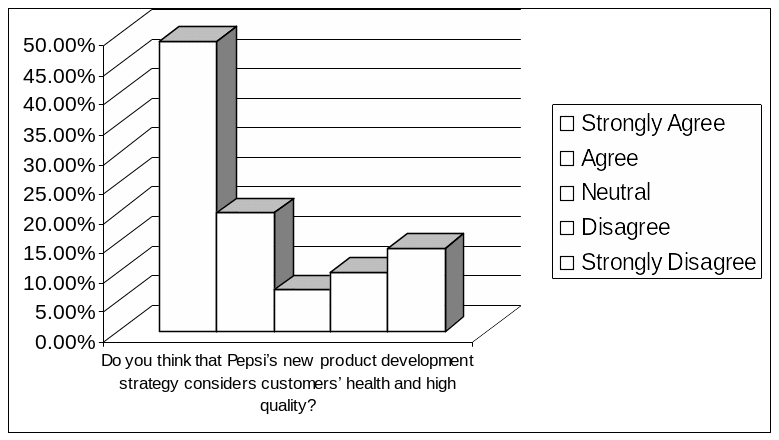
Do you think that Coca Cola’s new product development strategy considers customers’ health and high quality?
According to the primary data, 52% of the total participants strongly agreed that Coca cola’s new product development strategy considers customers’ health and high quality while 34% of interviewees simply agreed with this question, and only 4% of respondents were neutral or had no idea in this regard. Also, 6% of participants disagreed and 3% of respondents strongly disagreed; from the survey report and above-mentioned analysis of secondary data source, it can be said that the management of this company highly concentrates on tastes, flavor, and public health issues.
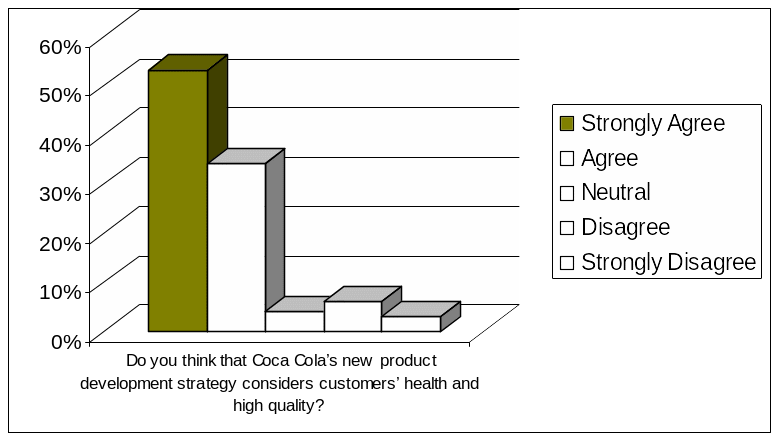
Cultural factors
Mittal (2010, p.29) also added that positioning assist to generate a particular space in the consumer’s mind if a company could able to position its products at the exact attention of customer would deliver very interesting outcomes, in the soft drink market there are the huge scenario of multination is being localized. For instance, Coca-Cola and PepsiCo are both have a long historical entry in the KSA where Mecca cola is another local soft drinks with little market share and was unable to position in the market by struggling with Coca-Cola and PepsiCo who have large market domination, due to their marketing performance the sales of Mecca cola was decreasing. Suddenly Mecca Cola started to propagate that both Coca-Cola and PepsiCo are US-originated company and the companies are enemies of Muslims, thus they called to boycott their soft drinks. By generating anti-American sentiment and a radical Islamic approach, Mecca Cola was capable to position itself as a soft drink for Muslims and gained a remarkable market share by passing back Coca-Cola and PepsiCo far apart
Supply Chain Management
Lin (2012) stated that the taste and pricing of the products of Coca Cola and Pepsi are almost similar, but the position of these companies is not the same in the global market, for instance, the sales revenue of Coca Cola is five to six times greater than Pepsi in the whole market. Most interesting, in the time of present global financial crisis, Pepsi faced enormous challenges for liquidity crisis though it responds appropriately on time; besides, in the past the great depression, Pepsi went into bankruptcy twice (Lin 2012). The following figure shows the coke dominance chain in more detail –
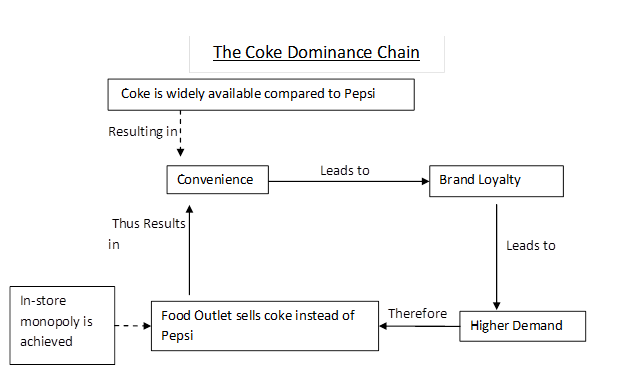
However, Coke is available everywhere compared to Pepsi, such as, in every food outlets of McDonald’s, Starbucks, KFC, and other fast food stores; however, Coke is widely available within a smaller radius for which the people of both rural and urban areas can purchase Coca Cola products (Lin 2012). Also, the purchasers of soft drinks do not bother about their drinks, but they want to save time and effort; considering this benefit, a consumer would purchase Coca Cola products more often though many other issues that make it dominant over Pepsi for example it’s pricing strategies, marketing policy, packaging and so on (Lin 2012).
Findings, Conclusions, and Recommendations
Introduction
The purpose of this chapter is to discuss the summary of findings, key recommendations from the primary data to develop the companies for the future, identify the limitation of the research particularly the data collection process, and provide a conclusion as well.
Summary of Findings
Previous research on the carbonated soft drinks industry mainly concentrated on the different factors related to consumer preferences, the effectiveness of advertising campaigns, estimating pricing strategies of Coke and Pepsi, cultural factors to operate a business in different countries, diversity management system, and financial analysis and so on. However, this research paper contributes to the body of scholarly knowledge by providing new findings of the different strategies used in Coca Cola and Pepsi while the researcher considered the standpoint of consumers and workforce of these two companies. Their research question was the extent to which business-level strategy, pricing strategy, brand promotion strategy, NPD, and market expansion strategy are effectual to manage Coca-Cola and Pepsi in the global market; however, a hypothesis based on Pepsi’s late introduction into the market, relative to its competitor Coca Cola, is the main reason behind its comparatively dismal performance in the market.
Limitations
Collection of data from an extensive target group was a limitation of this study while it was difficult to focus on the different areas of the research at a time. Both Coca Cola and Pepsi have a great presence in the global market for which to collect data from any particular country or region could mislead the research objectives, which influence the findings and the recommendations for future research. At the same time, data from any particular place could raise the question of the reliability and validity of the research for getting different perspectives in the conclusion from the survey report. One of the potential factors was maintaining a schedule to coordinate the entire research because of the unwillingness or fatigue of the target participants while they seem that it is a worthless function for them.
However, the questionnaire of this study has also included some open-ended questions for which the participants got the opportunity to provide their views without concerning the research aim and objectives; therefore, the researcher had to reject some of the questionnaires considering general norms of research formulation. The topic of this study (different Strategies of Coca-Cola and Pepsi) covers a vast area; therefore, findings cannot be generalized to the broader population due to the geographic limitation of one area, like, the presence of Coca Cola in Saudi Arabia is not outstanding due to ethical dilemmas in the promotional activities, but this is not a true picture for other nations. Simultaneously, Pepsi faced a severe challenge to sustain in the Chinese market and r Middle East; as a result, the feedback of the target participants cannot be assumed to represent other regions for both companies.
On the other hand, the survey populations particularly the managers of Pepsi and Coca Cola were extremely reluctant to communicate with the researcher regarding follow-up surveys for which the researcher of this study relied on the viewpoint of the employees and customers of these two companies.
Implications of the Study
This study has presented a comparative analysis of the strategies of Coca-Cola and PepsiCo, the findings of this research would assist both the companies to formulate their future strategy and would implicate the favorable features of this study that they feel more effective to conquer the strategic fights among the two. At the same time, academia and researcher working with the corporate strategy would be interested in the implication of this research to engage for further research in this area.
Recommendations
The management, board of directors, and other decision-makers of both Coca-Cola and Pepsi should concentrate on the corporate social responsibility and public health issues more carefully because the consumption of carbonated soft drinks has declined considerably because of the development of health awareness. To increase market share in the global market, these companies need to create value for the customers instead of maximizing profit margin because the people of developing countries like India have faced health due to consuming products of Coca-Cola and the consumers of developed countries have suffered problems because of overconsumption of soft drinks.
The above discussion demonstrates that both Coca-Cola and Pepsi used similar pricing strategies, but the position of Pepsi is not suitable enough; in this context, the management should increase the budget for the market research to restructure pricing strategy for different areas; however, this recommendation has been derived from survey reports. At the same time, the management, and board of directors of Pepsi should concentrate on the supply chain management and distribution channel to increase sales revenue because the products of Coca Cola is available everywhere but the purchasers have to provide more effort if they like Pepsi and this scenario is common in rural areas. Besides, Coca Cola gained a competitive advantage over Pepsi use advanced promotional strategies, for instance, Coca Cola has a long tradition to sponsor the large event; therefore, the marketers of Pepsi should try to use sponsorship strategy more effectively, for instance, it should target large event like American Idol, World Cup Football, or Olympic games and so on.
The management of Pepsi should conduct more research to take effective strategic decisions and implement this plan as well though it has a strong presence in the global market; at the same time, this study will help future researchers to find out loopholes regarding Pepsi’s strategy and conduct research.
Conclusion
The two giant of the carbonated beverage industry has been continuing strategic fight to conquer one over another to attain enhanced market share for about a century where the Coca-Cola enjoys more ‘competitive advantage’ for its earlier entry but there is no reason undermine the role of PepsiCo. PepsiCo has ensured its strong presence in every market of the Cola-Cola and gained a remarkable market share all over the globe. The rising health consciousness among the people has seriously affected the soft drinks market, but it does not mean the ‘Cola-War’ would be ended, both the companies engaged to remove the associated health risk by reducing fat, calories, artificial color and preservative and their strategic fight would be continued to gain enhanced market share.
Reference List
Andersson, E, Arvidsson, E & Lindström, C (2006). Coca-Cola or Pepsi: that is the Question. Web.
Angelkov, V. Black, T. & Green, A. (2003). Pepsi’s Strategy in the Carbonated Soft Drinks Market. Web.
BenLud (2013). Coca-Cola: Business Level Strategy. Web.
Bhushan, R. (2013). Coca-Cola moves to counter Pepsi’s IPL bonanza through entry-level price war, and market expansion. Web.
Burney, A. (2008). Inductive & Deductive Research Approach. Web.
Coca-Cola (2012). Product development. Web.
Fourni, P. (2012). Coca Cola pricing strategy. Web.
Golan, A. Karp, L. & Perloff, J. (1999). Estimating Coke and Pepsi’s Price and Advertising Strategies. Web.
Karanis, M. (2013). Pepsi Co. Business-Level Strategy. Web.
Lin, H. (2012). Coca-Cola vs. Pepsi: the Economics behind Coke’s Dominance. Web.
Liu, F. & Smit, W. (2012). Social Media Strategy: Learning from the Online Cola War. Web.
Mittal, A. (2010). Analysis of Marketing Strategy of Coca Cola and PepsiCoco. Web.
PepsiCo (2012). PepsiCo Announces Strategic Investments to Drive Growth. Web.
Stafford, L. (2013). Coca-Cola to spend $30 billion to grow globally. Web.
Yoffie, D. & Wang, Y. (2004). Cola Wars Continue: Coke And Pepsi In The Twenty-First Century. Web.
Questionnaire
Do you think that social media strategy of Coca-Cola is more effective than PepsiCo?
Do you think that Social Media Strategy of Pepsi should change to compete with Coca Cola?
Do you think that the brand promotion strategy of Coca Cola is more effective than PepsiCo?
Do you think Pepsi’s pricing strategy helps to increase customer value?
Do you think Coca Cola’s pricing strategy helps to increase customer value?
Do you think Pepsi and Coca Cola should restructure their pricing strategy?
Do you think that Pepsi’s market expansion strategy is advantageous for the company –
Do you think that Coca Cola’s market expansion strategy is advantageous for the company –
Do you think that the business level strategy of Coca Cola is more effective than PepsiCo?
Do you think Pepsi’s Sponsorship strategy is effective in global context?
Do you think Pepsi need to change their sponsorship policy?
Do you think Coca Cola’s Sponsorship strategy is effective strategy in global context?
Do you think Coca Cola need to change their sponsorship policy?
Do you think that Pepsi’s new product development strategy considers customers’ health and high quality?
Do you think that Coca Cola’s new product development strategy considers customers’ health and high quality?
